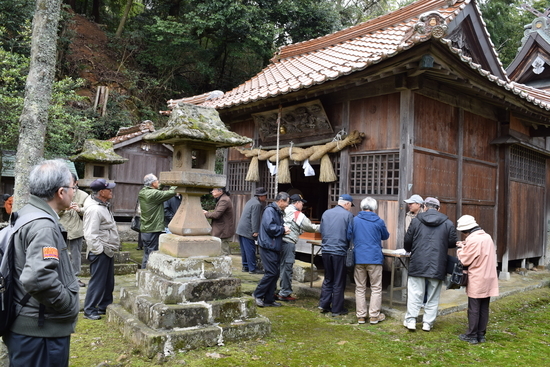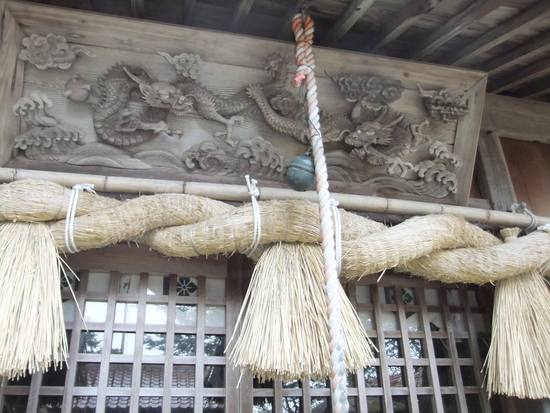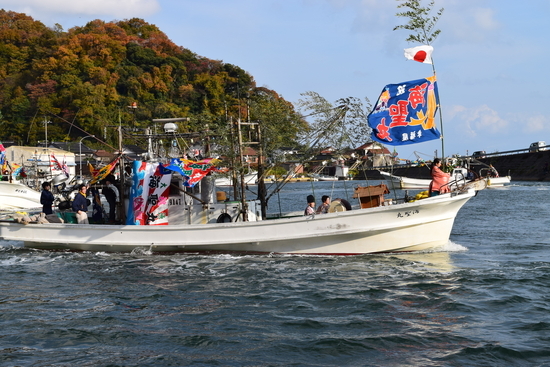Miho-jinja
| Bay Name | Fukuura |
|---|---|
| Shrine Name |
Miho jinja (current) Miho daimyoujin (former) |
| Deity |
Kotoshironushi no kami Mihotsuhime no mikoto |
| Location |
Matsue-shi Mihonoseki cho Fuku ura |
Fuku ura Miho daimyoujin
Asaborake kasumi no uchi ni momofune no
Arashifukurano okiyasumuran

You can pray for your wish to be granted at the torii gate on the bridge over the entrance to the cove at Fuku village. Miho jinja is serenely enshrined at the back of the cove. It is separate from the one of the same name listed as one of the Shikinaisha official shrines and it appears in the Fudoki as Miho yashiro. Both shrines have the same double hall structure.
According to the Fudoki, the Fuku ura land belongs to the Miho township, although in the mokkan (wooden information strips) unearthed at the Fujiwarakyu historical site in Nara, it is officially recorded as being a town in itself called Fukuryo,(written with different characters from today’s name) part of Shimane gun. There is a likelihood that in a time dating back further than the Fudoki, the Miho area was once called Fukuryo and instead of Mihonoseki, the central point of this land was actually what is today known as Fuku ura. Supposing this is the case , a former old address, ’Ofukura’ can be confirmed in Kumotsu over in the north suggesting the possibility that the span of the old ’Fuku ura’ wasn’t limited to the area covered by modern day Fuku bay and was in fact a location name that extended over a wider zone.
Keeping the name/reading of ’Fuku- ura’ in mind, the characters for this former ’Fukuryo’ can be read as both ’Fukura’ and ’Fukuro’. The latter also carrying the meaning of ’bag/sac’. Using this hypothesis, a point of interest is the idea that the shape of area from the shrine to the coast resembled that of a bag from ancient times and that at one point the central point of Fuku ura carried the address ’Moto (former) fuku ura’ slightly to the east.
In addition, there is the question as to why the 42 bay pilgrimage ends in Fuku ura as opposed to Mihonoseki. Perhaps there was an awareness of the need to pray for ’Fuku’ ( luck/fortune) at the end of the journey.

Exiting the bag-shaped Fuku ura coast leads you straight to the Matsue-Mihonoseki prefectural road making it look like you have missed Miho shrine, but after crossing the bridge and looking back, the shrine comes into view. It offers a view that almost looks like Miho shrine is holding a lucky bag in its embrace.
Looking up at the bells in the hall of worship, the structure looks quite old, but there is also a framed relief featuring two dragons face to face. This imposing sight becomes almost scary if gazed at for an extended period.
Miho shrine’s regular festival held to bestow health and long life on local residents, the ’Namasu matsuri’, takes place on November 22nd. The following day sees the Sea Dragon Festival where fishing boats gather at the harbor and offerings are given to ask for safety at sea and bountiful fishing hauls.
The Namasu festival occurs twice a year in both November and March. The day before, a measure of sticky brown rice that has been soaked in water is prepared along with sliced up radish and ground dried sardines and a spinach side dish. This food is made in offering to the kami Kotoshironushi and Mihotsuhime no mikoto. Worshippers gather food little by little, eat some on the spot and bring some home with them.
It is said that originally, the rice dish was prepared only by males at the fireplace within the shrine precincts. For some reason the spinach dish became a contribution by women. There is a generous theme to this particular event, which sees healthy food shared at a festival aimed at bringing a healthy long life.
The parade of fishing boats is a lively affair with drums and other sounds as well as a female shrine priest on board along with a representation of the sea dragon, Ryujin, surely a good pre-celebration ahead of a big catch of fish like sardines in the New Year.

| Bay Name | Fukuura |
|---|---|
| Shrine Name |
Miho jinja (current) Miho daimyoujin (former) |
| Deity |
Kotoshironushi no kami Mihotsuhime no mikoto |
| Location |
Matsue-shi Mihonoseki cho Fuku ura |
Fuku ura Miho daimyoujin
Asaborake kasumi no uchi ni momofune no
Arashifukurano okiyasumuran
You can pray for your wish to be granted at the torii gate on the bridge over the entrance to the cove at Fuku village. Miho jinja is serenely enshrined at the back of the cove. It is separate from the one of the same name listed as one of the Shikinaisha official shrines and it appears in the Fudoki as Miho yashiro. Both shrines have the same double hall structure.
According to the Fudoki, the Fuku ura land belongs to the Miho township, although in the mokkan (wooden information strips) unearthed at the Fujiwarakyu historical site in Nara, it is officially recorded as being a town in itself called Fukuryo,(written with different characters from today’s name) part of Shimane gun. There is a likelihood that in a time dating back further than the Fudoki, the Miho area was once called Fukuryo and instead of Mihonoseki, the central point of this land was actually what is today known as Fuku ura. Supposing this is the case , a former old address, ’Ofukura’ can be confirmed in Kumotsu over in the north suggesting the possibility that the span of the old ’Fuku ura’ wasn’t limited to the area covered by modern day Fuku bay and was in fact a location name that extended over a wider zone.
Keeping the name/reading of ’Fuku- ura’ in mind, the characters for this former ’Fukuryo’ can be read as both ’Fukura’ and ’Fukuro’. The latter also carrying the meaning of ’bag/sac’. Using this hypothesis, a point of interest is the idea that the shape of area from the shrine to the coast resembled that of a bag from ancient times and that at one point the central point of Fuku ura carried the address ’Moto (former) fuku ura’ slightly to the east.
In addition, there is the question as to why the 42 bay pilgrimage ends in Fuku ura as opposed to Mihonoseki. Perhaps there was an awareness of the need to pray for ’Fuku’ ( luck/fortune) at the end of the journey.
Exiting the bag-shaped Fuku ura coast leads you straight to the Matsue-Mihonoseki prefectural road making it look like you have missed Miho shrine, but after crossing the bridge and looking back, the shrine comes into view. It offers a view that almost looks like Miho shrine is holding a lucky bag in its embrace.
Looking up at the bells in the hall of worship, the structure looks quite old, but there is also a framed relief featuring two dragons face to face. This imposing sight becomes almost scary if gazed at for an extended period.
Miho shrine’s regular festival held to bestow health and long life on local residents, the ’Namasu matsuri’, takes place on November 22nd. The following day sees the Sea Dragon Festival where fishing boats gather at the harbor and offerings are given to ask for safety at sea and bountiful fishing hauls.
The Namasu festival occurs twice a year in both November and March. The day before, a measure of sticky brown rice that has been soaked in water is prepared along with sliced up radish and ground dried sardines and a spinach side dish. This food is made in offering to the kami Kotoshironushi and Mihotsuhime no mikoto. Worshippers gather food little by little, eat some on the spot and bring some home with them.
It is said that originally, the rice dish was prepared only by males at the fireplace within the shrine precincts. For some reason the spinach dish became a contribution by women. There is a generous theme to this particular event, which sees healthy food shared at a festival aimed at bringing a healthy long life.
The parade of fishing boats is a lively affair with drums and other sounds as well as a female shrine priest on board along with a representation of the sea dragon, Ryujin, surely a good pre-celebration ahead of a big catch of fish like sardines in the New Year.






